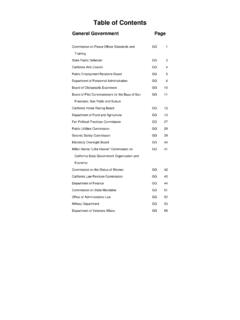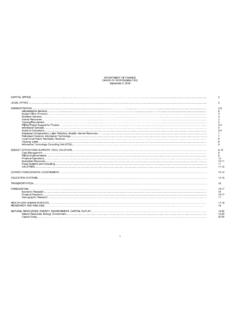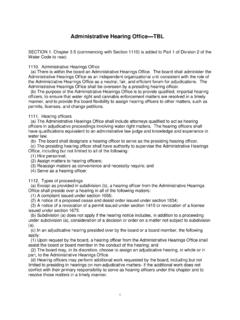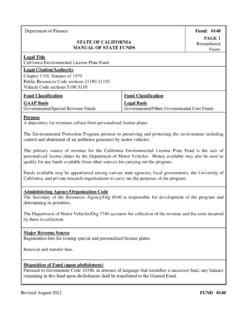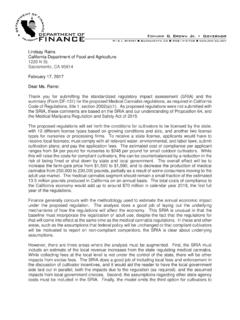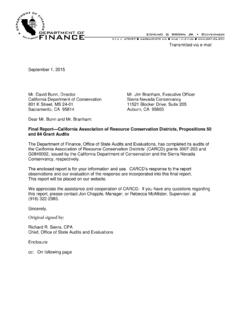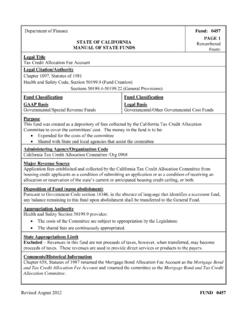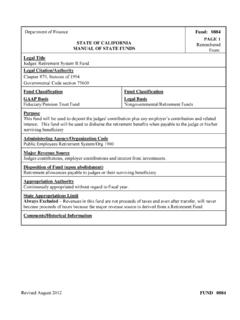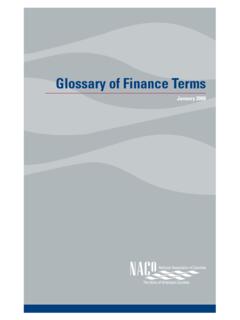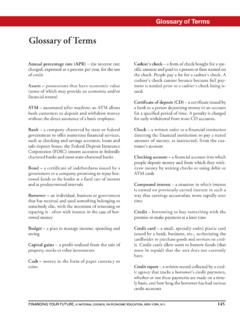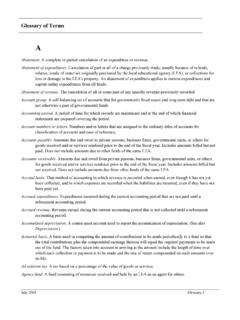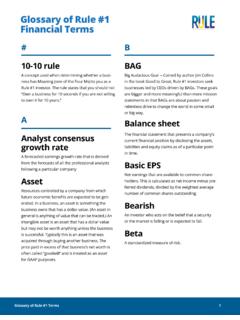Transcription of Glossary of Budget Terms - Department of Finance
1 Finance Glossary of Accounting and Budgeting Terms The following Terms are used frequently throughout the Governor s Budget , the Governor s Budget Summary, the annual Budget (Appropriations) Bill, and other documents. Definitions are provided for Terms that are common to many of these publications. For definitions of Terms unique to a specific program area, please refer to the individual Budget presentation. Certain Terms may be interpreted or used differently depending on the context, the audience, or the purpose. Abatement A reduction to an expenditure that has already been made. In state accounting, only specific types of receipts are accounted for as abatements, including refund of overpayment of salaries, rebates from vendors or third parties for defective or returned merchandise, jury duty and witness fees, and property damage or loss recoveries.
2 (See SAM 10220 for more detail.) Abolishment of Fund The closure of a fund pursuant to the operation of law. Funds may also be administratively abolished by the Department of Finance with the concurrence of the State Controller s Office. When a special fund is abolished, all of its assets and liabilities are transferred by the State Controller's Office to successor fund, or if no successor fund is specified, then to the General Fund. (GC 13306, 16346.) Accruals Revenues or expenditures that have been recognized for that fiscal year but not received or disbursed until a subsequent fiscal year. Annually, accruals are included in the revenue and expenditure amounts reported in departments Budget documents and year-end financial reports.
3 For budgetary purposes, departments expenditure accruals also include payables and outstanding encumbrances at the end of the fiscal year for obligations attributable to that fiscal year. Accrual Basis of Accounting The basis of accounting in which transactions are recognized in the fiscal year when they occur, regardless of when cash is received or disbursed. Revenue is recognized in the fiscal year when earned, and expenditures are recognized in the fiscal year when obligations are created (generally when goods/services are ordered or when contracts are signed). Also referred to as the full accrual basis of accounting. Administration Refers to the Governor's Office and those individuals, departments, and offices reporting to it ( , the Department of Finance ).
4 Administration Program Costs The indirect cost of a program, typically a share of the costs of the administrative units serving the entire Department ( , the Director's Office, Legal, Personnel, Accounting, and Business Services). "Distributed Administration" costs represent the distribution of the indirect costs to the various program activities of a Department . In most departments, all administrative costs are distributed. (See also Indirect Costs and Statewide Cost Allocation Plan. ) Administratively Established Positions Positions authorized by the Department of Finance during a fiscal year that were not included in the Budget and are necessary for workload or administrative reasons.
5 Such positions terminate at the end of the fiscal year, or in order to continue, must meet certain criteria under Budget Act Control Section (SAM 6406, CS ) Agency A legal or official reference to a government organization at any level in the state organizational hierarchy. (See the UCM for the hierarchy of State Government Organizations.) Or: A government organization belonging to the highest level of the state organizational hierarchy as defined in the UCM. An organization whose head (Agency Secretary) is designated by Governor's order as a cabinet member. Allocation A distribution of funds or costs from one account or appropriation to one or more accounts or appropriations ( , the allocation of employee compensation funding from the statewide 9800 Budget Act items to departmental appropriation items).
6 Allotment The approved division of an amount (usually of an appropriation) to be expended for a particular purpose during a specified time period. An allotment is generally authorized on a line item expenditure basis by program or organization. (SAM 8300 et seq.) Amendment A proposed or accepted change to a bill in the Legislature, the California Constitution, statutes enacted by the Legislature, or ballot initiative. A-Pages A common reference to the Governor's Budget Summary. Budget highlights now contained in the Governor's Budget Summary were once contained in front of the Governor's Budget on pages A-1, A- 2, etc., and were, therefore, called the A-Pages. Appropriated Revenue Revenue which, as it is earned, is reserved and appropriated for a specific purpose.
7 An example is student fees received by state colleges that are by law appropriated for the support of the colleges. The revenue does not become available for expenditure until it is earned. Appropriation Authorization for a specific agency to make expenditures or create obligations from a specific fund for a specific purpose. It is usually limited in amount and period of time during which the expenditure is to be recognized. For example, appropriations made by the Budget Act are available for encumbrance for one year, unless otherwise specified. Appropriations made by other legislation are available for encumbrance for three years, unless otherwise specified, and appropriations stating without regard to fiscal year shall be available from year to year until fully expended.
8 Legislation or the California Constitution can provide continuous appropriations, and voters can also make appropriations by approving ballot measures. An appropriation shall be available for encumbrance during the period specified therein, or if not specified, for a period of three years after the date upon which it first became available for encumbrance. Except for federal funds, liquidation of encumbrances must be within two years of the expiration date of the period of availability for encumbrance, at which time the undisbursed ( , unliquidated) balance of the appropriation is reverted back into the fund. Federal funds have four years to liquidate. (GC 16304, ) Appropriation Without Regard To Fiscal Year (AWRTFY) An appropriation for a specified amount that is available from year to year until fully expended.
9 Appropriations Limit, State (SAL) The constitutional limit on the growth of certain appropriations from tax proceeds, generally set to the level of the prior year's appropriation limit as adjusted for changes in cost of living and population. Other adjustments may be made for such reasons as the transfer of services from one government entity to another. (Article XIII B, 8; GC 7900 et seq; CS ) Appropriation Schedule The detail of an appropriation ( , in the Budget Act), showing the distribution of the appropriation to each of the programs or projects thereof. Assembly California's lower house of the Legislature composed of 80 members. As a result of Proposition 140 (passed in 1990) and Proposition 28 (passed in 2012), members elected in or after 2012 may serve 12 years in the Legislature in any combination of four-year state Senate or two-year state Assembly Terms .
10 Prior to Proposition 28, Assembly members could serve two-year Terms and a maximum of three Terms . (Article IV, 2 (a).) Audit Typically a review of financial reports or performance activity (such as of an agency or program) to determine conformity or compliance with applicable laws, regulations, and/or standards. The state has three central organizations that perform audits of state agencies: the State Controller s Office, the Department of Finance , and the California State Auditor. Many state departments also have internal audit units to review their internal functions and program activities. (SAM 20000, etc.) Augmentation An increase to a previously authorized appropriation or allotment.
